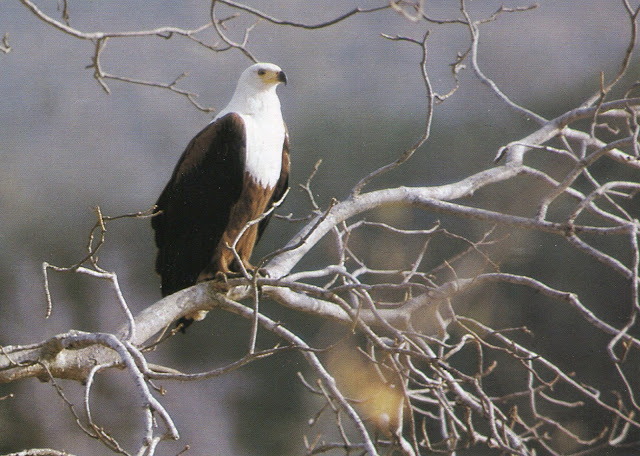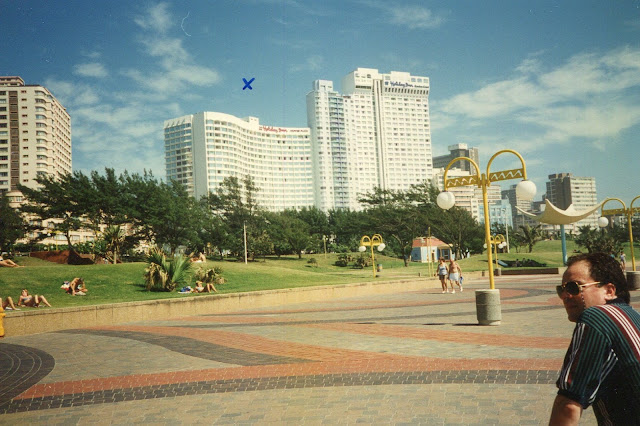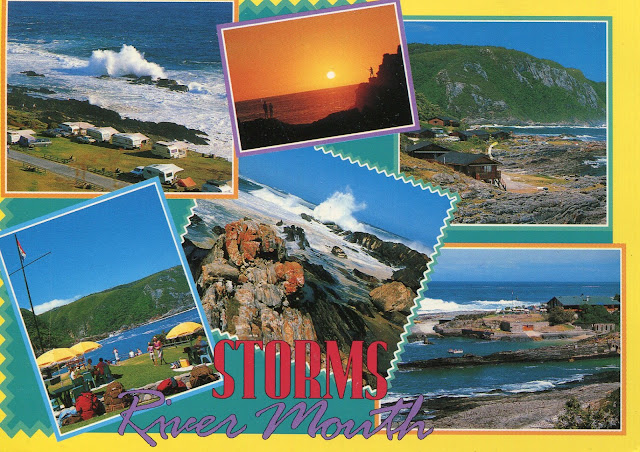As the country my wife grew up in after fleeing Rhodesia, and a place she had left while it was still under apartheid, a visit to South Africa had a very special appeal now that Nelson Mandela had been released, and elected president of the exciting new “Rainbow Nation”. So much hope rested on this one man, whose quiet dignity, in the face of a lifetime of inhuman treatment, had endeared him to everyone and prevented the country from plunging into civil war. Whether or not the goodwill he generated would be enough to overcome the bitter legacy of apartheid was something only time would tell, but as we landed in Johannesburg, we shared the sense of cautious optimism that seemed to pervade the country’s consciousness.
However, the brutal reality of barbed wire, burned out buildings, and miles of squatter camps, that greeted us upon our arrival, showed how much work was to be done. The first creature to greet us was Buxton the tortoise, a long time companion of one of Junie's few remaining relatives in the country. We were quick to discover that living like a tortoise was an apt metaphor for survival in the new republic, particularly in Johannesburg with its focus on security in the face of astronomical crime statistics.
Bridging the gap between the extreme differences in living conditions of
black and white people was clearly not going to be an easy task. Even more worrisome was the question of how
long people would be prepared to wait for their expectations to be fulfilled?
The rampant crime statistics were everyone’s favorite topic of conversation,
and with everybody’s house wired with alarms and barred against burglars, it
was obvious a sort of siege mentality had taken over.
Ironically enough, the safest place to be
in South Africa was in one of the game reserves, and so hopping into our rented
car we drove off to Kruger National Park, a vast 2 million hectare game reserve
along the Mozambique border. Getting
there involved more than a little wildness trying to cope with 160+km speeds
while driving along the shoulder of the road, visibility, fruit stands, and pedestrians be
damned, in order to facilitate the relentless and maniacal passion of everyone
around us for passing.

It was with a sense of relief when we finally pulled up to the “Malelane Gate” at the southern end of the park and entered the land of the Big 5 (lion, buffalo, rhino, elephant and leopard) to begin our photographic safari. We had booked our reservation and accommodations nearly a year in advance, and were pleasantly relieved to find everything was in perfect order when the game warden handed us our entrance pass.
It takes about five days to drive through Kruger and, with 2,500 kilometers of road for exploring, all you need is a map, binoculars and plenty of camera film. We hadn’t been in the park 20 minutes when we spotted our first zebra, and by the time we got to our rest camp that evening we had seen impala and other antelope, baboons, warthogs, wildebeest, and even a white rhinoceros. Absolutely amazing experience to see all the animals in their natural habitat, and be able to share their space.

Each of the camps has its own style of
buildings, and arriving at our first camp, “Skukuza”, we checked into a
spotless “rondavel”, a circular shaped thatched cottage designed to keep out
the evil spirits who like to hide in corners.
It felt as if we were part of a movie set as we walked around the
immaculately swept grounds, and admired the staff in their neatly pressed
uniforms. In a large banquet hall, a
formally laid dinner of game, accompanied of course by wonderful Cape wine, was
served by immaculately dressed (but occasionally barefoot) waiters in tuxedos.
Later that night while lying in our cozy beds, with their freshly ironed sheets, we could hear the sounds of lions and hyenas going about their gruesome business, and we understood why the camps are surrounded by electric fences. Gates close promptly at 6:30 p.m. each night, and you wouldn’t want to be on the wrong side when the hunting starts.
There are 12 main rest camps scattered throughout the park, along with a few picnic spots but, because the speed limit is between 30 - 50 km/hr, it takes most of the day to get from one camp to another. No sooner were we on our way the next morning, when we were stopped on the road by a herd of elephants. Nothing can ever prepare you for being confronted by one of these huge creatures who seem to appear out of nowhere, blissfully destroying trees and other vegetation as they eat their way across the countryside.
On the way to “Satara” we added giraffe,
hippo and honey badger to the viewing collection, not to mention a troop of
baboons who climbed all over our car, but we were careful to keep our windows rolled up. We also marvelled at the size of the anthills along the roadside. The early morning and late afternoon are the best times to see the
animals, though it seems the antelope are everywhere all the time, mingling by the hundreds
with the zebra, wildebeest and giraffe.



After a tasty roast warthog dinner we enjoyed a nature movie at the camp’s outdoor theatre, a surreal experience if there ever was one, and checked out the “Southern Cross” and “Orion’s Belt” in the clear night sky before going to bed. The lions were particularly vocal in this area, and it was somewhat disconcerting to realize we were a part of this daily life and death struggle to survive.
Up early to do a pre-breakfast runaround when the gates opened at 5:30 a.m. Rewarded with hyena, jackal, warthog, more elephants, giraffe, zebra, impala, wildebeest, storks, eagles, guinea fowl, kingfishers, hornbills, and a herd of fearsome looking but strangely quizzical, buffalo. As always the warning to never get out of the car was strictly followed because you never knew what was lurking in the tall grass.

As the animals sought shelter for the night, we sipped our sundowners and watched the sun sinking over the incredibly vast horizon. A great, fiery, red ball melting in the distance, reminding us of the timelessness of life on earth, and the futility of our own hopes, worries and dreams. As any of the magnificent animals below could tell us, the only thing for certain in this world is the sun rising and setting again each day. The rest is just chance, so enjoy life while you have it.
Up early as usual to check out the morning action, and while the lions continued to elude us we saw evidence of their handiwork with partially mauled zebra nervously grazing, and packs of hyenas and jackals, not to mention vultures, cleaning up the left-overs. February was a good time to be in the park because all the baby animals had just been born and were wandering around under the careful supervision of their parents. They all looked so sweet, even the ugly warthogs, and perhaps most touching, though certainly just as vicious, the baboons, who look and act almost human.
Continuing our journey north through the park, the landscape was subtley changing as the vegetation became more lush and dense. Stopped in at the “Letaba” camp for a lunch break and a tour of the museum with its displays of mounted tusks and photos of famous old bull elephants like “Shingwedzi” the name of our next camp.

In the morning the hyenas were busy with the remains of the lion kill, and driving to “Punda Maria” for a late breakfast, we had our path blocked for the last time by a herd of buffalo, and the odd elephant. Time seemed to have stopped during our week in the park, and we really regretted having to say goodbye to the peaceful savanna bushveld and all it’s magnificent creatures. Soon after leaving the last gatehouse, we realized what a refuge we had been enjoying as the madness of traffic and daily living confronted us on our way back to Johannesburg.
Our next destination was Durban, a subtropical city on a long surf beach that presented us with a very different set of photo opportunities. As the holiday mecca for people of the Transvaal and home to a large Indian community, Durban appeared to offer a very different sort of exotic flavour. However, once again we found a city paralyzed by ruffians who had turned the place into a mugger’s paradise, and frightened away the carefree tourists.
Confined, for safety reasons, to the wide boardwalk of the beach area, we nonetheless amused ourselves with a Zulu rickshaw ride, a tour of the snake park, shopping for African curios in the flea markets, and doing a little bodysurfing in the beautiful but shark infested ocean. Somehow, signs advising swimmers of the location of protective shark nets wasn’t all that reassuring, but it was easy to see how the warm temperatures and pretty bikinis could attract so many visitors.
From Durban it was off to Port Elizabeth, in the heart of the Eastern Cape province. The towns here all have English names as it was the border/buffer area between 19th century settlers and the Xhosa natives. For us it was a place to visit friends and get ourselves pointed in the direction of the “Garden Route” and South Africa’s magnificent coastline. It was also an opportunity to try our first “braai” a South African style of wood burning BBQ for cooking up enormous quantities of “boerewors” lamb sausage, chops and other meats.
First stops along the coastline were Jeffrey’s Bay, the surfers heaven, and Cape St. Francis, stunning examples of the hundreds of miles of beaches to follow, and great places to walk along collecting shells. Another notable stop is the Tsitsikamma Park with its Storms River that rushes through a narrow ravine to plunge headfirst into the mighty Indian Ocean surf.
Plettenberg Bay, Knysna, and Mossel Bay are other beautiful spots along the way, nestled in the indigenous yellowwood and pine forest and bordered by lagoons protected by the massive sand dunes. Altogether some of the most pleasing scenery and highway driving to be found anywhere in the world, with plenty of hiking trails, good restaurants and local attractions to interest anyone wanting to do a little further exploration.
For a change of scenery we decided to head
inland into the area known as the Little Karoo, a semi-desert area teeming with
ostrich farms. Oudtshoorn was the
unofficial capital of this region, especially for tourists, and besides being
able to stay in a beautifully restored 19th century Cape Dutch
farmhouse, we checked out the local Cango Caves and did a complete ostrich farm
tour that included a chance to ride one of the temperamental birds.


Enjoying the heat and quiet beauty of the countryside, we had the road to ourselves from Oudtshoorn to Robertson, a little town in the centre of the Breede River wine country. Just on the outskirts of the Little Karoo, this lovely area, filled with spotless wineries and homes built in the Cape Dutch style, and whose streets are lined with rose bushes and oak & jacaranda trees, seems far removed from the rest of Africa. But Africa it is, and travelling along the country roads lined with eucalyptus trees, it was the perfect place to begin our wine tasting experience.
At last we arrived at Cape Point, on the Cape of Good Hope, the tip of Africa where the warm Indian and cold Atlantic oceans meet. A windy, rugged spot, with an intense sort of forlorn beauty going hand in hand with the strange feeling of being at the end of a road at the end of a continent.
Cape Town, on the other hand, has a spectacular beauty that is set off by the geographically unique backdrop of a 1,000 foot flat topped mountain with virtually sheer cliffs, and surrounded by a dazzling collection of beaches and vineyards. In spite of being a refuge for all the white people fleeing the rest of the country, it is the most cosmopolitan city of South Africa, though it too, unfortunately, has miles of brutal townships and squatter camps.
Stayed in a lovely Greek style villa in the old naval port of Simonstown, where we had an incredible view of False Bay from our bedroom window and, courtesy of our fantastic hosts, a fabulous reunion party for Junie with all her childhood friends.

There are, however, stunning beaches of every flavor, including family ones like Fish Hoek, Muizenberg and Boulders, where you can swim with the penguins, or Noordhoek and Kommetjie for more intense surfing and plenty of dolphins, or Clifton, Sea Point & Llandudno, where the beautiful white people are trying to tan themselves black.
If you are feeling particularly energetic you can climb Table Mountain for an incredible view of the city or, if the cable car is working (which it wasn't on this trip) take it for the same view and save your poor legs.

One can also do “the Drive”, to Hout Bay on an exhilarating roadway, known as Chapman’s Peak drive, and feast on seafood, beer and wine at the strategically located hotel known to the locals as “Chappies”. A perfect place to forget all your troubles and gloat in the warmth of another “shitty day in Africa” !!!
You can also venture off on a “tippling
expedition” to the innumerable wineries of the Paarl and Stellenbosch area and
lose yourself in the magnificent countryside.
The wineries themselves often have deli-style shops where you can buy
everything for a perfect picnic, and enjoy it right on their beautifully
appointed grounds set amongst Cape Dutch style farm buildings.
There are plenty of shopping opportunities,
particularly at the Victoria & Alfred Waterfront complex with its acres of
interesting shops and restaurants in the revitalized wharf area. It’s also a good place to watch the “table
cloth” falling over Table Mountain.
However, no visit to Cape Town would be
complete without a journey to Robben Island, the infamous prison Nelson Mandela
called his home for 27 years. The same
boat used to transport the prisoners from the mainland is now used by the
tourists, and former inmates conduct the actual tour itself.
The journey to Robben Island offers another magnificent view of the city and its amazing setting, but while appreciating this beauty, just out of reach for those whose lives were ruined because of their political beliefs, it is worthwhile to ponder the words of the Future of Robben Island Committee:
“While we will not forget the brutality of
apartheid we will not want Robben Island to be a monument of our hardship and
suffering. We would want it to be a
monument reflecting the triumph of the human spirit against the forces of evil;
a triumph of freedom and human dignity over repression and humiliation; a
triumph of wisdom and largeness of spirit against small minds and pettiness; a
triumph of courage and determination over human frailty and weakness; a triumph
of non-racialism over bigotry and intolerance; a triumph of the new South
Africa over the old.”


















































































































































































































No comments:
Post a Comment